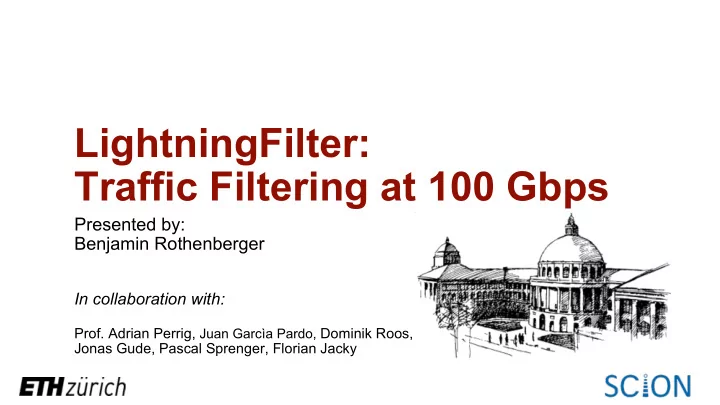

LightningFilter: Traffic Filtering at 100 Gbps Presented by: Benjamin Rothenberger In collaboration with: Prof. Adrian Perrig, Juan Garcìa Pardo, Dominik Roos, Jonas Gude, Pascal Sprenger, Florian Jacky
Project Goals • High-speed packet processing requires nanosecond operations Example: 64-byte packets @ 100Gbps: ~5ns processing time • • Nanosecond scale key establishment • Nanosecond scale packet authentication • Trivia: how “long” is a nanosecond? Answer: light travels about 30cm in 1ns •
Use Case: Network Error Message Authentication Internet AS A AS B BR BR ! C Client BR ! X Problem: only short time frame AS C BR à Only possible using symmetric cryptography Server S Solution: DRKey!
DRKey • Novel protocol based on symmetric cryptography • Intel AES-NI instructions enable key derivation within ~50 cycles à Nanosecond scale! • Key computation is up to 3 times faster than DRAM lookup! à Computing the key is faster than storing it in memory! à Foundation for many DDOS defense mechanisms
DRKey Performance Factor: ~ 1450x
Lightning Filter Traffic Filtering at 100 Gbps
Overview Internet Border Router normal traffic SCION traffic $$$ Lightning Firewall traffic Standard Firewall Filter Invalid traffic Authenticated traffic
System Design System Metric Exporter Prometheus Control Plane Data Plane Metrics Traffic Source Class. Auth. ............ ............ CONFIG FILE ............ ............ CLI L Administrator Duplicate Rate Supp. Limiting DRKey Mgmt Certificate Server Lightning Filter
Demo Outline 1. Attack scenario Attacker located anywhere in Internet à Source authentication • 2. Bandwidth capacity 120 Gbps traffic volumne • 3. Filtering based on source authentication Alternate between filtering and bypass every 30s • 4. Duplicate suppression 80 Gbps duplicates traffic, 40 Gbps legitimate traffic •
Attack Scenario: Internet Attacker AS A 100 Mbps Internet 100 Mbps 120 Gbps
Attack Scenario: Internet Attacker AS A 100 Mbps Internet LF 100 Mbps X 120 Gbps
Questions?
Backup Slides
DRKey Scenario • Communication between clients and server is authenticated using DRKey • Key derivation for L2 keys is delegated to server Server AS Clients Internet AS AS
DRKey Exchange Demo 1. Client requests the L2 key to communicate to the server from its local CS 2. L1 key has not been prefetched à L1 key exchange 3. Server fetches the derivation secret for its delegation from CS 4. Server then derives the same L2 key locally 5. Do 100 runs and calculate average execution time
DRKey Hierarchy • Key establishment using a multi-level key hierarchy • L0 : per-AS local secret key & per-AS public/private key pair • L1 : AS-level key establishment (typically prefetched!) • L2 : locally derive symmetric keys for end hosts
DRKey Key Exchange L1 key exchange CS CS Fetch Fetch L2 DS Internet key AS A AS B BR BR C S C C 1 Server Clients Locally derive L2 Key
Key Rollover Key Rollover Grace Period Grace Period t + 2 t + 1 t Active Key 𝐸𝑇 # Fetching Key 𝐸𝑇 #$& 0x0: Fetching Key 𝐸𝑇 #$( Key 𝐸𝑇 #$% Active Key 𝐸𝑇 #$% Key 𝐸𝑇 #$% 0x1: Fetching Key 𝐸𝑇 #$' Active Key 𝐸𝑇 #$' Key 𝐸𝑇 #$' 0x2:
Rate Limiting Refill rate Used tokens in last slice allocation for next silce I) aggregate III) distribute II) recompute c0 c2 c3 c1 c0 c1 c2 c3 Data Plane a) Packet processing c0 c2 c3 c1
Recommend
More recommend